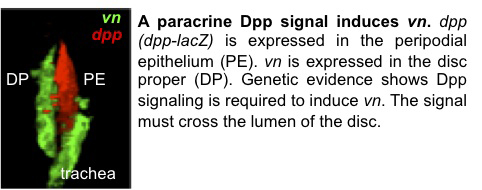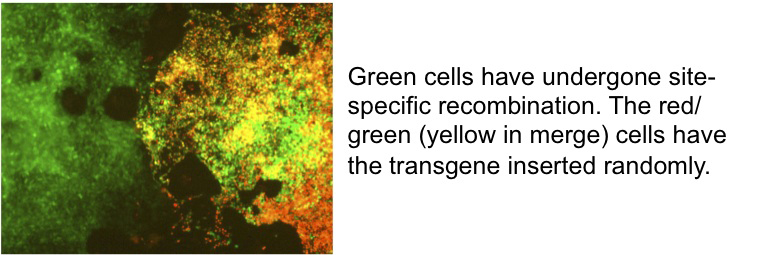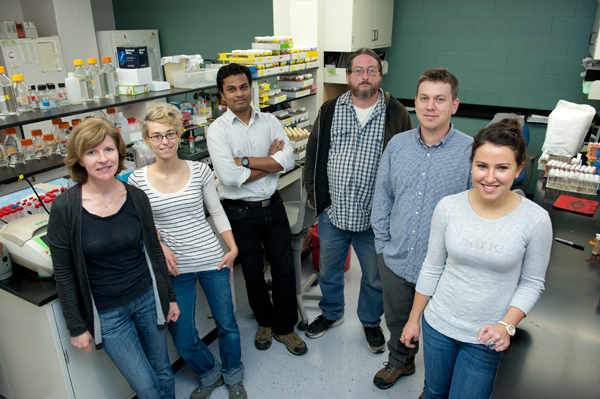Amanda Simcox
Contact Information
Emeritus Professor of Molecular Genetics
Areas of Expertise
- Drosophila Development
- Cell Culture Models of Cancer
- Molecular Evolution
We study EGF receptor signaling in the early wing disc. This simple system is about 30 cells in a just hatched larva and grows to about 150 cells in two days. Our goal is to decipher the complete gene regulatory network that operates in this short period of time to specify the adult wing and body wall of the thorax. The simplicity and small size of the tissue make this a good system to analyze. We found that a paracrine Dpp (BMP/TGF-β) signal induces an EGF ligand called Vn (similar to the vertebrate neuregulins). Once Vn is induced it maintains its own expression in an autocrine loop. The finding that these conserved signaling pathways are operating leads to an expectation that the circuit in the wing will be used in other tissues and animals.

Flies have four EGF ligands—one called Vn (a neuregulin) and three that are like TGF-α (including Spi). Surprisingly, we found that any of the TGF-α ligands can replace Vn and rescue a mutant. We had to titrate the dose of the TFG-α ligand, because each is more potent that Vn. Our results support the idea that ligand identity is not critical, but that a certain level of signaling is required for the correct cellular response.
spi expression" id="Figure2" src="/sites/molgen.osu.edu/files/simcox_amanda_fig2_0.jpg" style="width: 600px; height: 182px;" title="Figure2">
We have discovered genetic ways to generate Drosophila cell lines very efficiently. Expression of the Ras oncogene is one very powerful way to do this and we are using the cell lines to find new genes in the Ras pathway. We are using the cells to analyze tumor phenotypes. To enhance the range of possible experiments in Drosophila tissue culture we have developed a protocol to insert single transgenes into the same genomic site using site-specific recombination and a double drug selection.


Simcox Lab Members:
Graduate students:
- Geeta Palsule
- Ashley Heinaman
Undergraduate Students:
- Molly Josifov
- Sam Chen
- Nanki Hura
Research Associate:
- Shiva Singh
Postdoctoral Fellow:
- Uyen Tram
Publications
- Paul L, Wang SH, Manivannan SN, Bonanno L, Lewis S, Austin CL, Simcox A. (2013). Dpp-induced Egfr signaling triggers postembryonic wing development in Drosophila. Proc Natl Acad Sci U S A. 110:5058-63. PMID: 2347962
- Austin, C.L., Manivannan, S.N., and Simcox, A. (2014). TGF-α ligands can substitute for the neuregulin Vein in Drosophila development. Development 141(21):4110-4. PMID:25336739
- Manivannan, S.N., Jacobsen, T.L., Lyon, P., Selvaraj, B., Halpin, P., and Simcox, A. (2015). Targeted Integration of Single-Copy Transgenes in Drosophila melanogaster Tissue-Culture Cells Using Recombination-Mediated Cassette Exchange. Genetics 201: 1319-28. PMID: 26500255
- Manivannan, S.N., Lai, L.B, Gopalan, V., and Simcox, A. (2015) Transcriptional control of an essential ribozyme in Drosophila reveals an ancient evolutionary divide in animals. PLoS Genet 11(1): e1004893. doi: 10.1371/journal.pgen.1004893. PMID:25569672
- Lim MY, Ng AW, Chou Y, Lim TP, Simcox A, Tucker-Kellogg G, Okamura K. The Drosophila Dicer-1 Partner Loquacious Enhances miRNA Processing from Hairpins with Unstable Structures at the Dicing Site. Cell Rep. 2016 May 24;15(8):1795-808. PMID: 2718483
- Fagegaltier D, Falciatori I, Czech B, Castel S, Perrimon N, Simcox A, Hannon GJ. Oncogenic transformation of Drosophila somatic cells induces a functional piRNA pathway. Genes Dev. 2016 Jul 15;30(14):1623-35.
- Dequéant, M.L., Fagegaltier, D., Hu, Y., Spirohn, K., Simcox, A., Hannon, G.J., and Perrimon, N. (2015) Discovery of progenitor cell signatures by time-series expression analysis during Drosophila embryonic cell immortalization. Proc Natl Acad Sci U S A. 112: 12974-9. PMID: 26438832
- List of Published Work in MyBibliography
